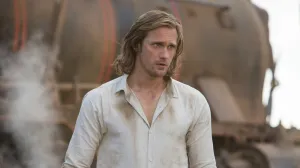Anyone who’s heard me speak about the interiors of Mesmo Delivery or The Dark Knight Returns: The Golden Child knows I adore the work of Rafael Grampá; anyone whose read those comics knows exactly why that is. Grampá’s work in comics is relatively sparse as the artist also directs short films and animation making each new issue featuring their name something to be coveted. Since the publication of The Golden Child in 2020, their work has only appeared on a handful of covers at DC Comics and Boom Studios but readers eager for more will be delighted by the 48-page first installment of Batman: Gargoyle of Gotham this week. The miniseries’ debut presents Grampá’s writing debut at DC and reveals new depths within one of the most vigorously impressive styles found in the direct market today.
Videos by ComicBook.com
In contrast with the unhinged and late-in-life Batman presented in The Golden Child, Grampá opts to focus on a much younger Bruce Wayne in Gargoyle of Gotham. It’s unclear exactly how old Batman is at the start of this story, but a lithe form and younger renditions of both Gordon and Alfred suggest a man in the first decade of his career. This choice of moment emphasizes a Batman working at the peak of their abilities and opens the door to the story ahead as Batman questions his own identity and methods. Early in the issue, Batman posits that Bruce Wayne must die for him to fully pursue his quest for vengeance. While the concept is vigorously opposed by Alfred, Batman is obsessed to a Nolan-esque degree and his internal struggles prove nearly as compelling as the external ones.
Those external battles are likely to be the initial draw for most readers and for good reason. In The Golden Child, Grampá was unleashed on some of truly wild conceits with grandiose battles between Kryptonians and New Gods providing Batman ample space to unleash sincerely awesome action. Grampá opts to contrast his new work with the over-the-top spectacle of that and Mesmo Delivery in what may be his most controlled action work to date. This vision of Batman emphasizes a detective and master strategist entirely focused on controlling himself, and it is reflected throughout the artwork.
Grampá’s layouts are almost entirely composed of vertical and horizontal lines with solid colors, often black, between panels. Only when Batman is taken by surprise when attacked by a new for or compelled to act wildly in order to save a life do the panels provide any angle and, with that, a temporary loss of control. The handful of moments in which Batman’s form moves beyond panel borders all focus on how others may perceive him as he appears larger than the systems surrounding him, as if already a legend.
That degree of control does not imply any loss of velocity or ferocity in Grampá’s style. Instead, the haunting Crytoon, a serial killer dressed in the style of a rubber hose-style cartoon character tied to a terrible tragedy, strikes a different mood in their confrontations with Batman. The use of mundane tools, like hammers and explosives, amidst a purely mortal cast fills sequences with a sense of dread. As bodies pile up the terrible aftermath of a single bullet or blunt instrument becomes frightening. The momentum seen sweeping through panels speaks to the frightening possibilities of very real violence and strikes a tone resonant with iconic works like Batman: Year One.
Batman: Gargoyle of Gotham sets the stage for one of the most dynamic visions of its eponymous hero and Gotham City seen this century. Not only does it present the stunning line work and compositions Rafael Grampá is already renowned for, but it reveals new depths to their cartooning in how it shapes both character and theme throughout the issue in a tightly controlled work. Wherever this gothic murder mystery is heading, readers may rest assured knowing that they will experience a viscerally tense saga of vengeance and obsession only possible in the comics medium.
Published by DC Comics
On September 12, 2023
Written by Rafael Grampá
Art by Rafael Grampá
Colors by Matheus Lopes
Letters by John Workman
Cover by Rafael Grampá








